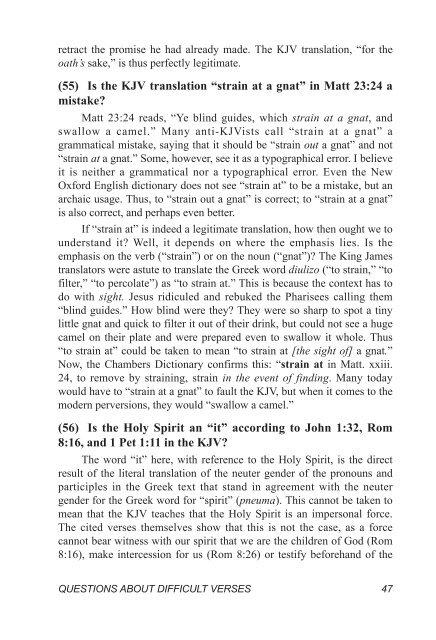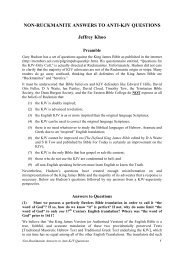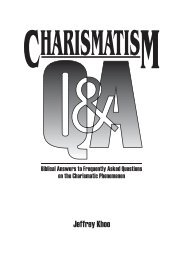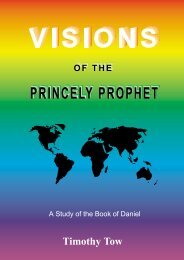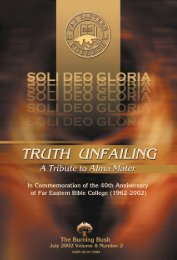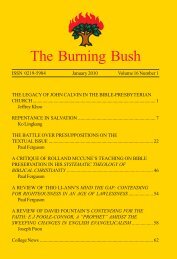KJV Questions and Answers - Far Eastern Bible College
KJV Questions and Answers - Far Eastern Bible College
KJV Questions and Answers - Far Eastern Bible College
- No tags were found...
You also want an ePaper? Increase the reach of your titles
YUMPU automatically turns print PDFs into web optimized ePapers that Google loves.
etract the promise he had already made. The <strong>KJV</strong> translation, “for theoath’s sake,” is thus perfectly legitimate.(55) Is the <strong>KJV</strong> translation “strain at a gnat” in Matt 23:24 amistake?Matt 23:24 reads, “Ye blind guides, which strain at a gnat, <strong>and</strong>swallow a camel.” Many anti-<strong>KJV</strong>ists call “strain at a gnat” agrammatical mistake, saying that it should be “strain out a gnat” <strong>and</strong> not“strain at a gnat.” Some, however, see it as a typographical error. I believeit is neither a grammatical nor a typographical error. Even the NewOxford English dictionary does not see “strain at” to be a mistake, but anarchaic usage. Thus, to “strain out a gnat” is correct; to “strain at a gnat”is also correct, <strong>and</strong> perhaps even better.If “strain at” is indeed a legitimate translation, how then ought we tounderst<strong>and</strong> it? Well, it depends on where the emphasis lies. Is theemphasis on the verb (“strain”) or on the noun (“gnat”)? The King Jamestranslators were astute to translate the Greek word diulizo (“to strain,” “tofilter,” “to percolate”) as “to strain at.” This is because the context has todo with sight. Jesus ridiculed <strong>and</strong> rebuked the Pharisees calling them“blind guides.” How blind were they? They were so sharp to spot a tinylittle gnat <strong>and</strong> quick to filter it out of their drink, but could not see a hugecamel on their plate <strong>and</strong> were prepared even to swallow it whole. Thus“to strain at” could be taken to mean “to strain at [the sight of] a gnat.”Now, the Chambers Dictionary confirms this: “strain at in Matt. xxiii.24, to remove by straining, strain in the event of finding. Many todaywould have to “strain at a gnat” to fault the <strong>KJV</strong>, but when it comes to themodern perversions, they would “swallow a camel.”(56) Is the Holy Spirit an “it” according to John 1:32, Rom8:16, <strong>and</strong> 1 Pet 1:11 in the <strong>KJV</strong>?The word “it” here, with reference to the Holy Spirit, is the directresult of the literal translation of the neuter gender of the pronouns <strong>and</strong>participles in the Greek text that st<strong>and</strong> in agreement with the neutergender for the Greek word for “spirit” (pneuma). This cannot be taken tomean that the <strong>KJV</strong> teaches that the Holy Spirit is an impersonal force.The cited verses themselves show that this is not the case, as a forcecannot bear witness with our spirit that we are the children of God (Rom8:16), make intercession for us (Rom 8:26) or testify beforeh<strong>and</strong> of theQUESTIONS ABOUT DIFFICULT VERSES47


